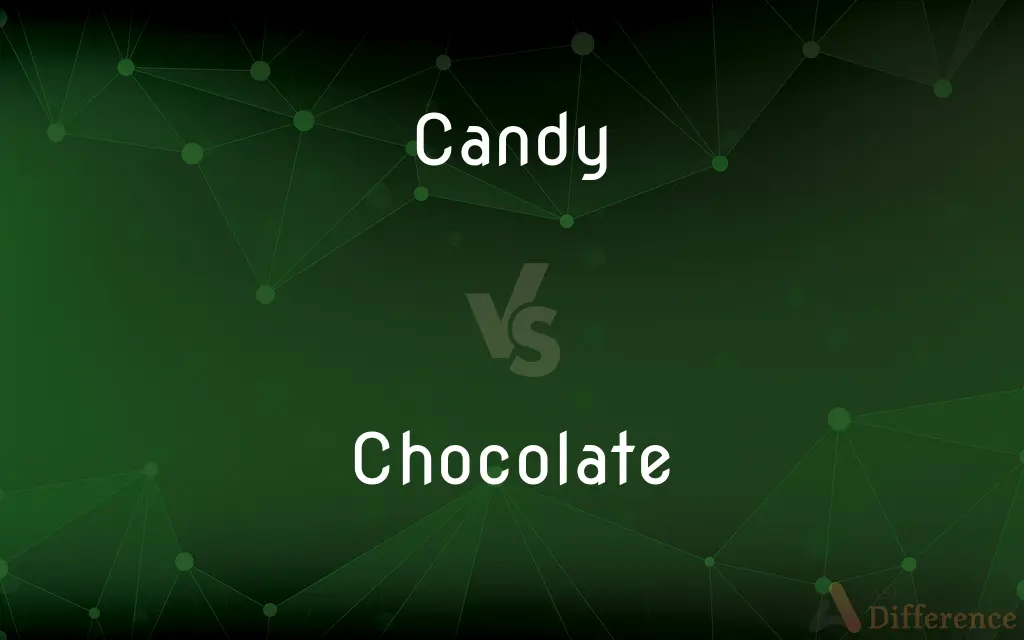Candy vs. Chocolate — What's the Difference?
By Tayyaba Rehman — Updated on September 18, 2023
"Candy" refers to sweet confections made from sugar or syrup, while "Chocolate" is a treat derived from roasted and ground cacao seeds.

Difference Between Candy and Chocolate
Table of Contents
ADVERTISEMENT
Key Differences
"Candy" is a broad term encompassing various sweet edibles made predominantly from sugar, syrup, or similar sweeteners. These can range from hard candies to gummies. In contrast, "Chocolate" specifically pertains to products made from roasted and ground cacao seeds, often combined with other ingredients like milk or sugar.
Many types of "Candy" do not contain any "Chocolate" at all. For example, a peppermint stick is candy, but it's not chocolate. Conversely, "Chocolate" can be a component in various candies, like in chocolate-covered nuts or toffees.
"Candy" can come in a variety of flavors, from fruity to minty. It's not limited to a particular taste profile. "Chocolate," however, has a distinctive taste derived from cacao, which can be altered in intensity depending on the type (e.g., dark, milk, or white chocolate).
The production processes for "Candy" and "Chocolate" also differ. Candies often involve boiling sugar or syrup to various temperatures, resulting in different textures. "Chocolate" requires a complex procedure, including fermenting, drying, roasting, and grinding cacao beans.
Both "Candy" and "Chocolate" have diverse cultural significances and histories. While candies have been part of human history for centuries in various forms, "Chocolate" traces its roots to ancient Mesoamerica, where cacao was consumed as a bitter beverage.
ADVERTISEMENT
Comparison Chart
Base Ingredient
Sugar, syrup, or other sweeteners
Cacao seeds
Varieties
Hard candy, gummies, licorice, etc.
Dark, milk, white, etc.
Flavor Profiles
Diverse: fruity, minty, sugary, etc.
Derived from cacao, can be sweet, semi-sweet, bitter, etc.
Texture
Varies: hard, chewy, soft, etc.
Typically smooth, but can vary
Historical Origin
Various forms across many cultures
Traced back to ancient Mesoamerica
Compare with Definitions
Candy
A sweet confection made primarily of sugar.
She loves the fruity flavor of the candy.
Chocolate
A treat derived from the fermentation, drying, and roasting of cacao beans.
Authentic chocolate has a distinct taste profile.
Candy
A sugary treat that can be hard or soft in texture.
The hard candy took a while to dissolve in his mouth.
Chocolate
A sweet treat that can be dark, milk, or white.
She prefers milk chocolate over other varieties.
Candy
A sugar-based treat that comes in various shapes and sizes.
The kids were excited to see the candy in their gift bags.
Chocolate
A confection made from roasted and ground cacao seeds.
The dark chocolate had a rich, intense flavor.
Candy
An edible treat that can be chewy or gummy.
He prefers chewy candy over other types.
Chocolate
A product often combined with sugar, milk, or other ingredients.
The chocolate bar had a hint of hazelnut in it.
Candy
A term that encompasses a range of sweet delights.
The store had a vast array of candy on display.
Chocolate
A versatile ingredient used in cooking, baking, and confectionery.
She used the chocolate to make a delicious dessert.
Candy
Candy, also called sweets (British English) or lollies (Australian English, New Zealand English), is a confection that features sugar as a principal ingredient. The category, called sugar confectionery, encompasses any sweet confection, including chocolate, chewing gum, and sugar candy.
Chocolate
Chocolate is a food product made from roasted and ground cacao pods, that is available as a liquid, solid or paste, on its own or as a flavoring agent in other foods. Cacao has been consumed in some form since at least the Olmec civilization (19th-11th century BCE), and the majority of Mesoamerican people - including the Maya and Aztecs - made chocolate beverages.The seeds of the cacao tree have an intense bitter taste and must be fermented to develop the flavor.
Candy
A rich sweet confection made with sugar and often flavored or combined with fruits or nuts.
Chocolate
Fermented, roasted, shelled, and ground cacao seeds, often combined with a sweetener or flavoring agent.
Candy
A piece of such a confection.
Chocolate
A beverage made by mixing water or milk with chocolate.
Candy
(Slang) An illicit drug, especially one, such as cocaine, that has a sugary appearance or a drug in pill form, such as MDMA.
Chocolate
A small, chocolate-covered candy with a hard or soft center.
Candy
To cook, preserve, saturate, or coat with sugar or syrup
Candy apples.
Candy ginger.
Chocolate
A grayish to deep reddish brown to deep grayish brown.
Candy
Edible, sweet-tasting confectionery containing sugar, or sometimes artificial sweeteners, and often flavored with fruit, chocolate, nuts, herbs and spices, or artificial flavors.
Chocolate
Made or flavored with chocolate
Chocolate pudding.
Candy
A piece of confectionery of this kind.
Chocolate
Of a grayish to deep reddish brown to deep grayish brown.
Candy
Crack cocaine.
Chocolate
A food made from ground roasted cocoa beans.
Chocolate is a very popular treat.
Candy
(uncountable) An accessory (bracelet, etc.) made from pony beads, associated with the rave scene.
Candy kid; candy raver
Chocolate
A drink made by dissolving this food in boiling milk or water.
Candy
(obsolete) A unit of mass used in southern India, equal to twenty maunds, roughly equal to 500 pounds avoirdupois but varying locally.
Chocolate
(countable) A single, small piece of confectionery made from chocolate.
He bought her some chocolates as a gift. She ate one chocolate and threw the rest away.
Candy
(cooking) To cook in, or coat with, sugar syrup.
Chocolate
(uncountable) A dark, reddish-brown colour/color, like that of chocolate (also called chocolate brown).
As he cooked it the whole thing turned a rich, deep chocolate.
Candy
(intransitive) To have sugar crystals form in or on.
Fruits preserved in sugar candy after a time.
Chocolate
A black person; (uncountable) blackness.
Candy
(intransitive) To be formed into candy; to solidify in a candylike form or mass.
Chocolate
Made of or containing chocolate.
Candy
To conserve or boil in sugar; as, to candy fruits; to candy ginger.
Chocolate
Having a dark reddish-brown colour/color.
Candy
To make sugar crystals of or in; to form into a mass resembling candy; as, to candy sirup.
Chocolate
(slang) Black relating to any of various ethnic groups having dark pigmentation of the skin.
Candy
To incrust with sugar or with candy, or with that which resembles sugar or candy.
Those frosts that winter bringsWhich candy every green.
Chocolate
To add chocolate to; to cover (food) in chocolate.
Candy
To have sugar crystals form in or on; as, fruits preserved in sugar candy after a time.
Chocolate
To treat blood agar by heating in order to lyse the red blood cells in the medium.
Candy
To be formed into candy; to solidify in a candylike form or mass.
Chocolate
A paste or cake composed of the roasted seeds of the Theobroma Cacao ground and mixed with other ingredients, usually sugar, and cinnamon or vanilla.
Candy
Any sweet, more or less solid article of confectionery, especially those prepared in small bite-sized pieces or small bars, having a wide variety of shapes, consistencies, and flavors, and manufactured in a variety of ways. It is often flavored or colored, or covered with chocolate, and sometimes contains fruit, nuts, etc.; it is often made by boiling sugar or molasses to the desired consistency, and than crystallizing, molding, or working in the required shape. Other types may consist primarily of chocolate or a sweetened gelatin. The term may be applied to a single piece of such confection or to the substance of which it is composed.
Chocolate
The beverage made by dissolving a portion of the paste or cake in boiling water or milk.
Candy
Cocaine.
Chocolate
A beverage made from cocoa powder and milk and sugar; usually drunk hot
Candy
A weight, at Madras 500 pounds, at Bombay 560 pounds.
Chocolate
A food made from roasted ground cacao beans
Candy
A rich sweet made of flavored sugar and often combined with fruit or nuts
Chocolate
A medium to dark brown color
Candy
Coat with something sweet, such as a hard sugar glaze
Common Curiosities
What's the main ingredient in candy?
Most candies are primarily made of sugar or syrup.
Is all chocolate considered candy?
No, while many chocolate products are candies, pure chocolate or baking chocolate isn't typically eaten as candy.
Where does chocolate originate from?
Chocolate comes from cacao seeds, which originated in Mesoamerica.
Can candies have chocolate in them?
Yes, many candies are either coated in chocolate or have chocolate as a main ingredient.
Are gummies considered candy?
Yes, gummies are a type of chewy candy.
Can candy be sugar-free?
Yes, some candies are made using sugar substitutes and are labeled as sugar-free.
How is dark chocolate different from milk chocolate?
Dark chocolate contains more cacao and less milk compared to milk chocolate.
Is white chocolate true chocolate?
While it contains cocoa butter, white chocolate lacks cacao solids, differentiating it from dark and milk chocolate.
What gives chocolate its characteristic flavor?
The roasted and ground cacao seeds provide chocolate's distinctive taste.
Are lollipops a type of candy?
Yes, lollipops are a type of hard candy.
How is chocolate processed?
Chocolate is made by fermenting, drying, roasting, and grinding cacao beans.
Can people be allergic to chocolate or candy?
Yes, individuals can have allergies to ingredients in both chocolate and other candies.
Can chocolate be unsweetened?
Yes, unsweetened chocolate is often used for baking.
How long can candy be stored?
Depending on the type, candies can have varied shelf lives, but many last for months if stored properly.
Why does some chocolate have a white coating when old?
This is called "chocolate bloom," resulting from fat or sugar crystals rising to the surface. It's safe to eat but might alter the texture.
Share Your Discovery

Previous Comparison
Invasive vs. Evasive
Next Comparison
Protege vs. ProdigyAuthor Spotlight
Written by
Tayyaba RehmanTayyaba Rehman is a distinguished writer, currently serving as a primary contributor to askdifference.com. As a researcher in semantics and etymology, Tayyaba's passion for the complexity of languages and their distinctions has found a perfect home on the platform. Tayyaba delves into the intricacies of language, distinguishing between commonly confused words and phrases, thereby providing clarity for readers worldwide.














































